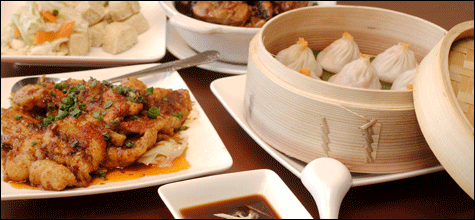
STEAM DREAM Xiao long bao (steamer of dumplings) is like Peking ravioli with super-juicy insides.
Photo by Brook Griffin.
Taiwan’s culinary situation is as wonderfully confused as its history and politics. It’s part of China, but it is not. Over the past century, Taiwan/Formosa has spent most of its time as a colony of Japan; the second-most time as part of China, but outside the control of the government of China; and the third-most time as the recognized government of China, without actually governing anything on the mainland. For 30,000 years, there were no Han Chinese in Taiwan. Today, they outnumber the indigenous population.
Jo Jo Taipei
617.254.8889 |103 Brighton Avenue, Allston | Open daily, 11:30 am–11:30 pm | DI, MC, VI | No liquor | No valet parking | Entrance up a slight threshold bump |
The contemporary cuisine of Taiwan, for its part, is influenced by Chinese, Spanish, Dutch, and Japanese colonists, and most recently by the 1949 immigration of the pre-Communist officials and their cooks, from all the provinces of China. There used to be an argument over whether Taiwan had the best Chinese food; today, there is food that is distinctly Taiwanese. And even that has rapidly changed. Of the characteristic dishes of Taiwan on the menu at Jo Jo Taipei, I could find only one in my trusty 1969–1979 volumes by Fu Pei Mei, the Julia Child of Taiwan at the time.I started tracking these changes when a helpful reader, Ju Chien Hsu, e-mailed me some pointers after I reviewed one of the first Taiwanese restaurants in Chinatown, 13 years ago. “You must try the Crispy Smelled Bean Curd,” she wrote. “This is uniquely Taiwanese and definitely an acquired taste. (I consider tofu to be the cheese of Chinese cuisine; think of this as one of the rank ones.)” All these years later, I finally found a restaurant that featured the dish on an English-language menu, and took advantage of the suggestion. (Although Jo Jo Taipei has translated almost everything, there is a little blackboard with about six specials in Chinese. Once we ordered enough exotic food, our excellent waitress attempted to explain what they were.)
Each table at Jo Jo Taipei starts with a small dish of Spanish peanuts, and another of a sweet-hot lightly pickled salad, mostly cabbage. Then a waitress comes with a tray of potential appetizers.
To start, we had the apparent Taiwanese madeleine, the “crispy smelly bean curd” ($5.99), which is in fact not like a rank cheese. The appearance and texture are like that of deep-fried ordinary un-smelly bean curd. The aroma is not like Camembert but like tripe — only more so, since tripe dishes in this cuisine tend to be more about texture than aroma. The thrill must come from eating something that smells gross but is visually innocuous. It helps to have a chili dip, as many cultures combine it with tripe.
Stewed pig ear ($4.99), which we ordered from the waitress’s tray of appetizers, is a bit cartilaginous, but it tastes like sesame and soy and looks like uncooked bacon. If you don’t want anything that either smells gross or looks gross, there is also a novel seaweed salad ($3.99). It’s cut into wider strips than the Japanese-Korean version, and is mildly flavored, with the same sesame-soy theme.
Our other appetizers came off the Chinese menu blackboard. What was described to us as “like a dumpling, but with all one piece” ($4.99) turned out to be made of saccharine potato flour, so it was like a square of meaty jello with a filling of fine-cut beef and mushrooms (very savory), plus a syrupy red sauce with pepper. I ate every bite. “Buns with soup inside and egg” ($7.95) turned out to be a famous dish, originally from Shanghai, called xiao long bao, sometimes listed as XLB. These are eight pouch-shaped dumplings, served in a steamer. The liquid inside is scalding, so it’s safer to eat them after a brief pause. The egg part is orange and some of it seeps out of the hole on top — think of thin-skinned Peking ravioli, with super-juicy insides. The dip for these is shredded ginger and soy. (There is a version of these, with thicker skins, in one of Pei Mei’s books.)
We had only three entrées, but all were superb. “Three cups chicken” ($10.95) is a dish of braised bony pieces of chicken with Asian basil, like a hot pot with almost all the sauce cooked out. The dish is a development of a braised dish from Jiangxi province that was originally much oilier, but is now just a bowl of exquisite morsels. Flounder fillet ($12.99) is a large plate of pieces of fried fish, with more of the sweet-hot cabbage and a light chili sprinkle-sauce. I couldn’t stop taking more. For something green, the waitress suggested “Chinese watercress” ($8.99). In reality, it was ong choy (water spinach), a nice green with hollow stems that trap extra sauce, in this case a simple garlicky white one. White rice (99 cents) is sticky and fragrant, a treat in itself.